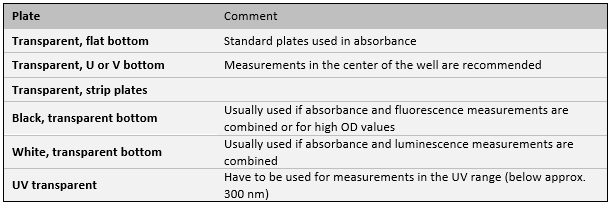Selecting the right plate for a measurement
Comments on plate suitability for which different measurements
Recommended plates based on measurement modes
Absorbance
Absorbance measurements are performed through the plate. Therefore, plates used must have a transparent bottom. Depending on the reader, plates with 1-1536 wells can be measured, as well as plates with a lid or sealing . Note that lids or sealings increase background, so blanking is recommended.
Fluorescence (FI) top and fluorescence polarization (FP):
These measurements are performed from the top, so opaque plates can be used. We recommend using black because the material absorbs reflections and has less autofluorescence. For best signal:noise ratio, use plates with black walls and a black bottom.
Transparent plates should not be used with fluorescence as reflections or unspecific signals can significantly impair sensitivity. Plates can be used with a lid, but the lid also reduces sensitivity. Using white plates may be advantageous for very weak signals.

Fluorescence (FI) bottom:
This measurement is performed from below the plate, so a transparent bottom is obligatory. We recommend using plates with black walls and a transparent bottom.
Transparent plates should not be used with fluoresence as reflections or unspecific signals can significantly impair sensitivity. Lids can be used and do not significantly influence the measurement outcome.

TRF, TR-FRET:
TRF and TR-FRET are usually measured from the top and therefore opaque plates are used. Depending on the application and the reader, white or black plates should be used. Please check recommended settings for a specific reader/application for the right plate to use.
Lids, transparent and transparent bottom plates are not recommended.

Luminescence and AlphaScreen®:
White plates are superior for luminescence measurements. The white plate material reflects light emitted by the sample and therefore increases sensitivity. Make sure to select the correct plate definition file in the software to guarantee optimal performance.
White plates with a transparent bottom may be used if luminescence is, for example, combined with absorbance, or if samples are to be visually checked under a microscope. The transparent bottom increases crosstalk (quenching the signal after measurement may be an option). White adhesive tape is available to cover the plate bottom and reduce crosstalk, but it may still be significant.
Don’t use transparent plates or plates with lids as this will result in crosstalk between wells.
For AlphaScreen® measurements, we recommend solid white or light grey plates.
Store white microplates in the dark and do not expose them to daylight right before measurement. White plates absorb light and this autophosphorescence can result in an inconsistent measurement background.

Further help
For further help, please refer to our Helpdesk.
Link to Tecan Product Page
401817-015